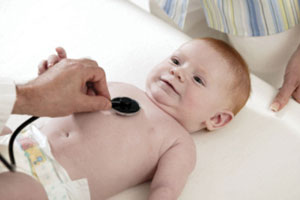CALLS for routine pulse oximetry testing in newborn babies before discharge have been strengthened by a UK study involving tens of thousands of infants.
Researchers, writing in The Lancet, found pulse oximetry identifies cases of critical congenital heart defects that go undetected with standard approaches. (1)
They said their findings enhanced the strong evidence for adopting routine screening with pulse oximetry, a non-invasive test for hypoxaemia, which is present in most life-threatening cases of congenital heart defects.
Between February 2008 and January 2009, 20 055 newborns were screened with pulse oximetry prior to discharge from six UK maternity units, and followed up until they were 12 months of age.
The sensitivity of pulse oximetry was 75% for critical congenital heart defects (those potentially causing death or requiring invasive intervention before 28 days), and 49% for major congenital heart defects (potentially causing death or requiring invasive intervention before 12 months).
Sensitivity was 58% for critical cases and 29% for major cases in those babies where congenital heart defects had not been suspected antenatally.
When the pulse oximetry was combined with routine antenatal ultrasound and newborn physical examination screening, 92% of critical congenital heart defects were detected.
Congenital heart defects are one of the leading causes of infant deaths in developed countries.
“Pulse oximetry is a safe, non-invasive, feasible and reasonably accurate test, which has a sensitivity that is better than that of antenatal screening and clinical examination”, the researchers wrote.
“It adds value to existing screening procedures and is likely to be useful for identification of critical congenital heart defects that would otherwise go undetected.
The researchers found that pulse oximetry also helped detect other conditions requiring medical intervention. Of the 169 infants (0.8%) who had false-positive results with pulse oximetry screening, 27% had other problems such as respiratory disorders or infections.
Six of the 20 055 babies tested had critical congenital heart defects not picked up with pulse oximetry (false negatives). No babies died, but two went on to have cardiac surgery.
A related comment in the The Lancet, led by US paediatric cardiologist Dr William Mahle, said the sensitivity of pulse oximetry was fairly low and the false-positive rate was high. However, the comment said compared with current approaches “pulse oximetry looks increasingly feasible. (2)
“Can we, therefore, endorse a strategy that is far from ideal, but better than what we have already?
“The compelling data provided by [the researchers] support inclusion of pulse oximetry into the care of the newborn baby”, the comment said.
– Sophie McNamara
1. Lancet 2011; 5 August (online)
2. Lancet 2011; 5 August (online)
Posted 8 August 2011

 more_vert
more_vert